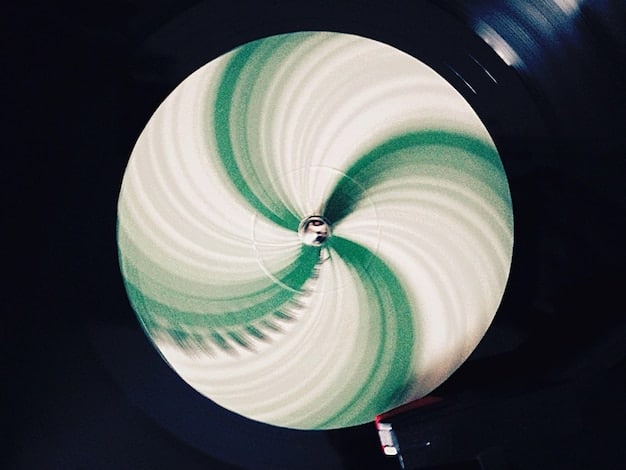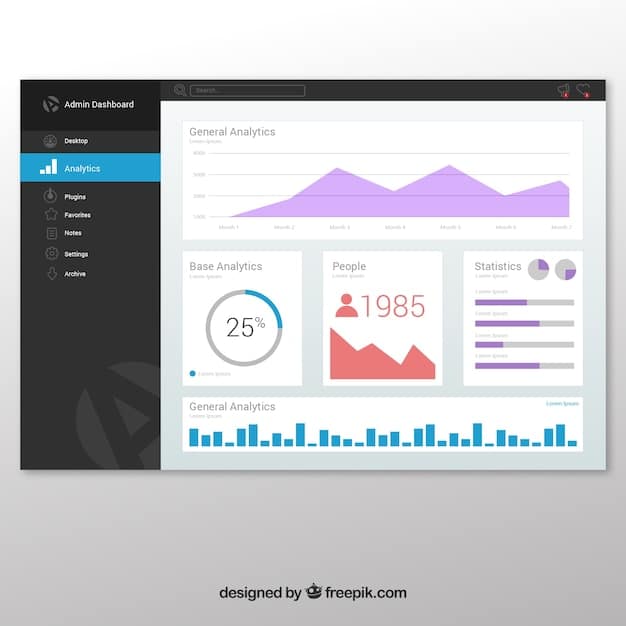Measure Success as an Independent Label: Tracking Progress & KPIs

Measuring success for independent labels involves tracking key performance indicators (KPIs) like sales, streaming numbers, social media engagement, and brand awareness, alongside setting realistic goals and adapting strategies based on performance data.
For independent labels: how to measure your success and track your progress is a crucial aspect of sustainable growth. Unlike major labels, independent labels often operate with limited resources, making it essential to focus on key performance indicators (KPIs) to ensure effective resource allocation and strategic development.
Understanding Success Metrics for Independent Labels
Defining success for an independent label goes beyond just financial gains; it encompasses artistic fulfillment, building a strong community, and leaving a lasting impact on the music scene. Initially, it’s useful to think about key metrics beyond the cash flow, such as social impact and the engagement that the music you’re helping to make gets with the audience. The metrics you use should ultimately reflect your goals.
Defining Your Goals
Before diving into metrics, clarify your goals. Are you aiming to break even, cultivate niche genres, or launch artists into mainstream success? Setting some goals might be setting targets for community growth, or artist reach, or perhaps to break even on a project.
- Financial Sustainability: Achieving profitability and reinvesting in new projects.
- Artistic Influence: Discovering and promoting unique voices.
- Community Building: Fostering relationships with fans and artists.
Choosing the Right KPIs
Identify KPIs that align with your goals. These may include sales figures (physical and digital), streaming numbers, social media engagement, and website traffic. You may wish to weigh these figures and give some more priority over others. For example, downloads might be more useful to you than YouTube views or visa versa.

Tracking these metrics involves using tools such as Google Analytics, social media analytics dashboards, and music distribution platform reports. It requires consistent monitoring and analysis to derive meaningful insights.
In summary, effectively measuring success involves setting clear goals, choosing the right KPIs, and utilizing data analytics to track progress and make informed decisions. It’s about balancing financial viability with artistic integrity and community engagement.
Financial Metrics: Tracking Revenue and Profit
Financial metrics are crucial for independent labels as they directly reflect the label’s ability to sustain itself and invest in future projects. Examining revenue streams, profit margins, and cost management provides a clear picture of the label’s financial health.
Sales Performance
Tracking sales of digital downloads, physical copies, and merchandise is essential. Identify top-selling artists, albums, and tracks to understand what resonates with your audience.
Stream Revenue
Monitor streaming revenue from platforms like Spotify, Apple Music, and Amazon Music. Analyze which tracks and albums are generating the most plays and identify areas for promotional focus.
Cost Management
Efficient cost management is vital for profitability. Track production costs, marketing expenses, distribution fees, and administrative overhead to identify areas for cost reduction and optimization.
- Production Costs: Recording, mixing, and mastering expenses.
- Marketing Expenses: Advertising, PR, and content creation costs.
- Distribution Fees: Costs associated with getting music onto streaming platforms and into stores.
By closely tracking these financial metrics, independent labels can make informed decisions about pricing, promotions, and investments. Understanding the financial performance of each artist and release allows for targeted strategies to maximize revenue and profit.
In brief, financial metrics, including sales, stream revenue, and cost management, are vital for assessing the economic health of independent labels, enabling them to make informed decisions about investments and resource allocation.

Digital Engagement: Measuring Online Impact
In the digital age, online engagement is a key indicator of an independent label’s reach and influence. Measuring digital engagement involves assessing website traffic, social media presence, and email marketing effectiveness.
Website Analytics
Use tools like Google Analytics to track website traffic, bounce rates, and user behavior. Identify popular pages, content that drives engagement, and sources of traffic to optimize your online presence.
Social Media Performance
Monitor social media metrics such as followers, likes, shares, and comments. Analyze which content performs best and tailor your strategy to maximize engagement and reach. Use social media dashboards to track and visualize these metrics in one place.
Email Marketing Effectiveness
Track open rates, click-through rates, and conversion rates for email marketing campaigns. Segment your audience and personalize messages to improve engagement and drive sales.
- Open Rates: Percentage of recipients who opened your email.
- Click-Through Rates: Percentage of recipients who clicked on a link in your email.
- Conversion Rates: Percentage of recipients who completed a desired action, such as making a purchase.
By continuously monitoring and analyzing these digital engagement metrics, independent labels can optimize their online strategies, build a stronger fan base, and drive more traffic and sales.
In conclusion, leveraging website analytics, social media performance, and email marketing effectiveness offers independent labels essential insights into their digital presence, enabling them to adapt their strategies and build stronger online communities.
Brand Awareness and Recognition
Building a recognizable brand is crucial for independent labels to stand out in a crowded market. Measuring brand awareness and recognition involves tracking media mentions, conducting surveys, and monitoring brand sentiment.
Media Mentions
Track how often your label and artists are mentioned in blogs, magazines, podcasts, and other media outlets. Use tools like Google Alerts and Mention to monitor mentions and assess the reach and impact of your PR efforts.
Conducting Surveys
Gather feedback from fans and industry professionals through surveys. Ask about their awareness of your label, their perception of your brand, and their satisfaction with your releases and services.
Monitoring Brand Sentiment
Use social listening tools to monitor sentiment around your label. Analyze whether mentions are positive, negative, or neutral to understand how your brand is perceived by the public.
- Positive Sentiment: Indicates that people have a favorable view of your brand.
- Negative Sentiment: Suggests areas where you need to improve your brand image or address concerns.
- Neutral Sentiment: Means your brand is being mentioned without strong positive or negative connotations.
By actively tracking these elements, independent labels can refine their branding efforts, enhance their reputation, and build a loyal following.
In essence, brand evaluation can offer useful insights into media presence, consumer feedback, and general perception, enabling independent brands to hone their brand image, boost their reputation, and garner a dedicated fan base.
Artist Development and Retention
The success of an independent label is closely tied to the growth and retention of its artists. Measuring artist development and retention involves tracking artist milestones, assessing artist satisfaction, and monitoring artist engagement.
Tracking Artist Milestones
Monitor key milestones in each artist’s career, such as album releases, tour dates, media appearances, and award nominations. Celebrate successes and provide support during challenges.
Assessing Artist Satisfaction
Regularly communicate with artists to understand their needs and concerns. Conduct surveys or one-on-one meetings to gather feedback on your label’s services and support.
Monitoring Artist Engagement
Track how actively artists engage with their fans on social media and at live performances. Encourage artists to build personal connections and foster a sense of community.
By focusing on artist development and retention, independent labels can create a supportive ecosystem that attracts and retains talented musicians, leading to long-term success.
To summarize, by nurturing artist advancement and ensuring their retention, labels may develop an encouraging atmosphere that draws skilled artists, culminating in lasting achievements.
Setting Realistic Goals and Adapting Strategies
Setting realistic goals and adapting strategies based on performance data is crucial for sustained growth. Regularly review your progress, analyze your successes and failures, and adjust your approach as needed.
SMART Goals
Set SMART goals that are Specific, Measurable, Achievable, Relevant, and Time-bound. For example, instead of setting a vague goal like “increase sales,” set a specific goal like “increase digital download sales by 20% in the next quarter.”
Regular Performance Reviews
Conduct regular performance reviews to assess your progress toward achieving your goals. Analyze your KPIs and identify areas where you are succeeding and areas where you need to improve.
Strategy Adaptation
Be willing to adapt your strategies based on performance data. If a particular marketing campaign is not working, be prepared to make changes or try a different approach. Flexibility and adaptability are key to long-term success.
- Flexibility: Being open to new ideas and approaches.
- Adaptability: Adjusting your strategies based on changing circumstances.
By setting realistic goals and adapting strategies based on performance data, independent labels can stay competitive and achieve sustainable growth.
Consequently, setting up practical goals and modifying plans derived from performance analytics ensures ongoing label advancement, enabling competitive viability and sustained expansion.
| Key Aspect | Brief Description |
|---|---|
| 🎯 Goal Setting | Define achievable and clear objectives. |
| 📊 KPI Tracking | Monitor sales, streams, and engagement metrics. |
| 📣 Brand Building | Enhance recognition and positive sentiment. |
| 🎵 Artist Dev | Support artist growth and satisfaction. |
FAQ
Key metrics include sales figures, streaming numbers, social media engagement, website traffic, and media mentions. These KPIs help assess the effectiveness of your strategies and overall growth.
Measure brand awareness by tracking media mentions, conducting surveys to gather feedback, and monitoring brand sentiment on social media and other online platforms using social listening tools.
Set SMART goals: Specific, Measurable, Achievable, Relevant, and Time-bound. Regularly review your progress and adjust your strategies based on performance data to ensure continued growth.
Digital engagement is crucial as it provides insight into your online impact and fan base. Monitor website analytics, social media performance, and email marketing effectiveness to build stronger relationships with your audience.
Artist development and retention are critical because they foster a supportive ecosystem that attracts and retains talented musicians. This leads to long-term success for both the label and its artists through mutual growth.
Conclusion
Measuring success as an independent label requires a multifaceted approach, combining financial analysis, digital engagement tracking, brand awareness monitoring, and artist development. By setting realistic goals and adapting strategies based on data, independent labels can thrive in the competitive music industry, building sustainable businesses and fostering artistic innovation.





